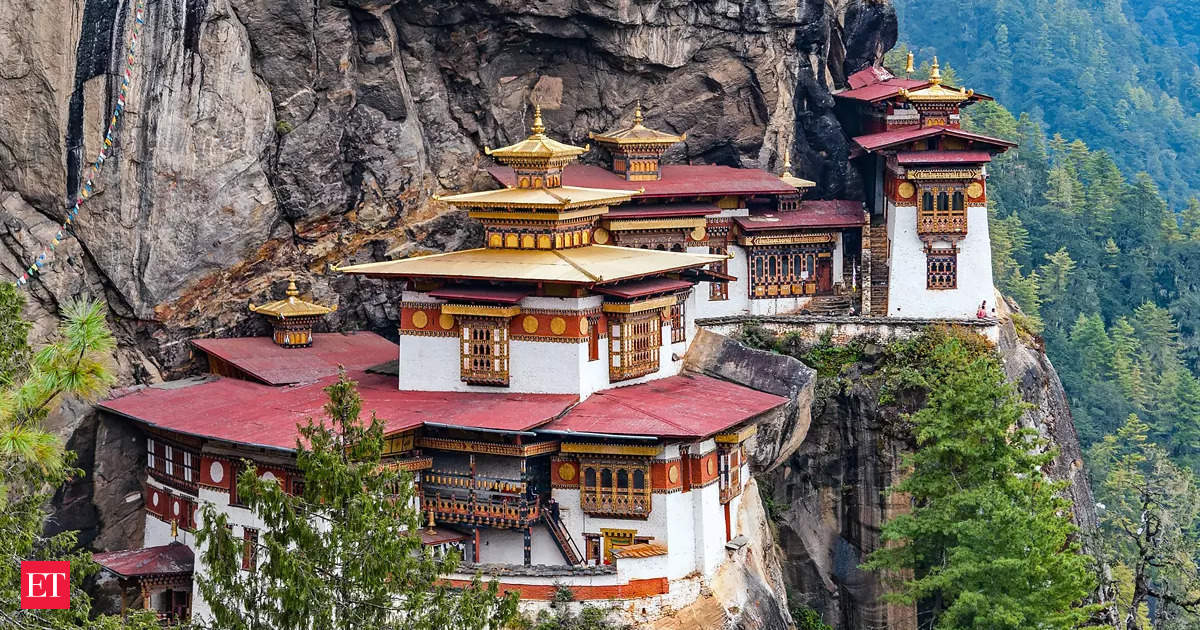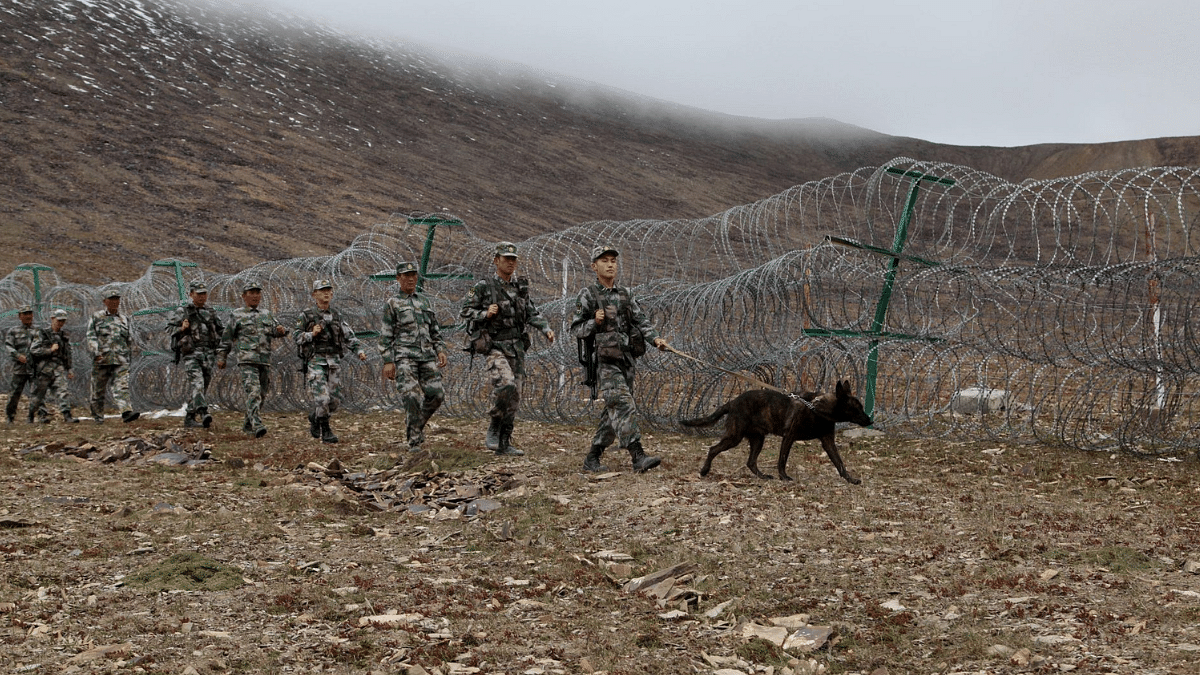You are using an out of date browser. It may not display this or other websites correctly.
You should upgrade or use an alternative browser.
You should upgrade or use an alternative browser.
India-Bhutan Relations.
- Thread starter Gautam
- Start date

India pledges to invest Rs 2 billion in Bhutan's Gyalsung Infra Project
On Saturday, the first tranche of the grant that was presented will be used for the DeSuung for Gyalsung (DFG) programme as a special India-Bhutan Friendship Project. The DFG seeks to engage about 11,000 DeSuups in the Gyalsung infrastructure construction project through a hybrid skilling and...

China-Bhutan inch closer to demarcation of disputed border, India watches closely
China claims around 764 sq km of land in Bhutan, in a dispute that dates to occupation of Tibet in 1950s. Meeting last week established joint technical group on border delimitation.
 theprint.in
theprint.in
Looks like we are loosing bhutan slowly.
TSHERING Topgay was sworn in last month as the Prime Minister of Bhutan, succeeding Lotay Tshering. He had led the People’s Democratic Party to victory in the elections to the national assembly. The Bhutan Tendrel Party, a new entrant led by Pema Chewang, emerged as the main Opposition party. Meanwhile, the United Nations announced that Bhutan was no longer an LDC (least developed country), though economic distress is around the corner, even as India will ‘bridge-finance’ Bhutan’s 12th and 13th Five-Year Plans. Between 2008 and 2013, then PM Jigme Thinley expanded Bhutan’s diplomatic relations by reaching out to several countries, except the P5 nations. Towards the end of his term, Thinley made serious overtures to the Chinese, causing unease in India.
The Global Times sees an Indian hand in opposing Bhutan-China diplomatic relations. The regime change following pro-Chinese overtures was more than a coincidence. When I visited Bhutan after the 2017 Doklam episode, I noticed an undercurrent of anti-India sentiment as some Bhutanese wanted to open up to China.
In an interview with an Indian newspaper in October last year, then PM Lotay Tshering discussed the dramatic progress in the border talks with China between 2020 and 2023. Referring to the three-step roadmap, he emphasised that there were no ‘real differences between Bhutan and China’ and that one more meeting ‘while we are in office will clinch the issue’. He added: “We hope to see the border demarcation materialise.” Asked whether Doklam would be traded for land in the north — Jakarlung and Pasamlung valleys — Lotay confirmed this, adding that neither side had evidence to claim it. This set the cat among the pigeons. Traditionally kept in the loop over Bhutan-China border talks, India appeared to have been left out at that time.
In November last year, King Jigme Khesar Namgyel Wangchuck visited New Delhi and met PM Narendra Modi. Media reports suggested that bilateral issues were discussed, which the joint statement covered. But there was no mention of the Bhutan-China border talks in the statement. Of course, the two leaders must have covered the issue, but not a whisper came out. Later, in November, Lotay was trounced in the first round of the election, securing less than 15 per cent of the votes. In December, the King announced Bhutan’s biggest connectivity and mega city project, the Gelephu Mindfulness City. Gelephu, which lies on the Bhutan-Assam border, will have an international airport and rail link intended to establish an economic corridor connecting South Asia with South-East Asia through the troubled North East. The King has travelled to all 20 districts in Bhutan, selling the smart city project as a game-changer for national happiness. Gelephu also acted as a diversion from the border talks.
In December last year, Maxar Technologies reported fresh Chinese encroachments of the three ‘well-off society’ villages across the Amu Chu river in Bhutan. This is in addition to a number of dual-use villages constructed in Doklam. In 2017, India had intervened in Doklam as per treaty agreements to prevent China from constructing a road to its perceived but disputed tri-junction at Gympoche. According to the 2012 protocol, the site issue has to be resolved between India’s tri-junction at Batangla and the Chinese at Gympoche, trilaterally between India, China and Bhutan. The Chinese have built a road hugging Amu Chu south towards Jampheri ridge, but to get there, Torsa Nala has to be crossed. The Indian Army is prepared for the worst case scenario — the Doklam plateau lost to Beijing in a Bhutan-China package deal — but will have contingency plans to prevent crossing the red line in Torsa and thwarting Chinese attempts to capture the Jampheri ridge, which overlooks the Siliguri Corridor. Further, the 17 Strike Corps will keep a hawk’s eye over Chumbi Valley to deter China from any misadventure towards Jampheri, pending resolution of the tri-junction matter.
According to Maxar Technologies and independent reports in December last year, the Chinese penetration of Bhutan was significant but not widely known. India is silent about it. China has replaced India as Bhutan’s biggest trading partner and accounts for a quarter of the total trade. The Chinese power corporation is involved in the Chukha and Punatsangchhu hydel projects. The Sino Hydro Corporation, China Gezhouba Group, China Road and Bridge Corporation and other Chinese state-owned companies are working on different projects. The China Railway Engineering Group is exploring railway connections through the Lhasa-Gyantse link. The Chinese Communist Party’s state-owned companies have built the 220-km Friendship Highway, a 290-km lateral road, a 100-km Gelephu-Gointre road and 60-km Wangdue-Trongsa road between 2013 and 2018.
While Chinese companies are mining for gold and copper, fibre optic cables are being laid, expanding the mobile network. Huawei has been involved in 3G and 4G services since 2009. Chinese high-end tourists visited in high numbers (80,000 before the Covid pandemic). The details of financing of these development projects is not known, though the push for establishing diplomatic relations was intensified in 2023, when Topgay said: “Theoretically, how can Bhutan not have bilateral relations with China? The question is when and in what manner.”
If King Khesar Wangchuck has been testing the waters, delinking border talks with those China has with India, he may perhaps also slow down on the Doklam swap.
Doklam shadow over India-Bhutan relations
TSHERING Topgay was sworn in last month as the Prime Minister of Bhutan, succeeding Lotay Tshering. He had led the People’s Democratic Party to victory in the elections to the national assembly. The Bhutan Tendrel Party, a new entrant led by Pema Chewang, emerged as the main Opposition party. Meanwhile, the United Nations announced that Bhutan was no longer an LDC (least developed country), though economic distress is around the corner, even as India will ‘bridge-finance’ Bhutan’s 12th and 13th Five-Year Plans. Between 2008 and 2013, then PM Jigme Thinley expanded Bhutan’s diplomatic relations by reaching out to several countries, except the P5 nations. Towards the end of his term, Thinley made serious overtures to the Chinese, causing unease in India.
The Global Times sees an Indian hand in opposing Bhutan-China diplomatic relations. The regime change following pro-Chinese overtures was more than a coincidence. When I visited Bhutan after the 2017 Doklam episode, I noticed an undercurrent of anti-India sentiment as some Bhutanese wanted to open up to China.
In an interview with an Indian newspaper in October last year, then PM Lotay Tshering discussed the dramatic progress in the border talks with China between 2020 and 2023. Referring to the three-step roadmap, he emphasised that there were no ‘real differences between Bhutan and China’ and that one more meeting ‘while we are in office will clinch the issue’. He added: “We hope to see the border demarcation materialise.” Asked whether Doklam would be traded for land in the north — Jakarlung and Pasamlung valleys — Lotay confirmed this, adding that neither side had evidence to claim it. This set the cat among the pigeons. Traditionally kept in the loop over Bhutan-China border talks, India appeared to have been left out at that time.
In November last year, King Jigme Khesar Namgyel Wangchuck visited New Delhi and met PM Narendra Modi. Media reports suggested that bilateral issues were discussed, which the joint statement covered. But there was no mention of the Bhutan-China border talks in the statement. Of course, the two leaders must have covered the issue, but not a whisper came out. Later, in November, Lotay was trounced in the first round of the election, securing less than 15 per cent of the votes. In December, the King announced Bhutan’s biggest connectivity and mega city project, the Gelephu Mindfulness City. Gelephu, which lies on the Bhutan-Assam border, will have an international airport and rail link intended to establish an economic corridor connecting South Asia with South-East Asia through the troubled North East. The King has travelled to all 20 districts in Bhutan, selling the smart city project as a game-changer for national happiness. Gelephu also acted as a diversion from the border talks.
In December last year, Maxar Technologies reported fresh Chinese encroachments of the three ‘well-off society’ villages across the Amu Chu river in Bhutan. This is in addition to a number of dual-use villages constructed in Doklam. In 2017, India had intervened in Doklam as per treaty agreements to prevent China from constructing a road to its perceived but disputed tri-junction at Gympoche. According to the 2012 protocol, the site issue has to be resolved between India’s tri-junction at Batangla and the Chinese at Gympoche, trilaterally between India, China and Bhutan. The Chinese have built a road hugging Amu Chu south towards Jampheri ridge, but to get there, Torsa Nala has to be crossed. The Indian Army is prepared for the worst case scenario — the Doklam plateau lost to Beijing in a Bhutan-China package deal — but will have contingency plans to prevent crossing the red line in Torsa and thwarting Chinese attempts to capture the Jampheri ridge, which overlooks the Siliguri Corridor. Further, the 17 Strike Corps will keep a hawk’s eye over Chumbi Valley to deter China from any misadventure towards Jampheri, pending resolution of the tri-junction matter.
According to Maxar Technologies and independent reports in December last year, the Chinese penetration of Bhutan was significant but not widely known. India is silent about it. China has replaced India as Bhutan’s biggest trading partner and accounts for a quarter of the total trade. The Chinese power corporation is involved in the Chukha and Punatsangchhu hydel projects. The Sino Hydro Corporation, China Gezhouba Group, China Road and Bridge Corporation and other Chinese state-owned companies are working on different projects. The China Railway Engineering Group is exploring railway connections through the Lhasa-Gyantse link. The Chinese Communist Party’s state-owned companies have built the 220-km Friendship Highway, a 290-km lateral road, a 100-km Gelephu-Gointre road and 60-km Wangdue-Trongsa road between 2013 and 2018.
While Chinese companies are mining for gold and copper, fibre optic cables are being laid, expanding the mobile network. Huawei has been involved in 3G and 4G services since 2009. Chinese high-end tourists visited in high numbers (80,000 before the Covid pandemic). The details of financing of these development projects is not known, though the push for establishing diplomatic relations was intensified in 2023, when Topgay said: “Theoretically, how can Bhutan not have bilateral relations with China? The question is when and in what manner.”
If King Khesar Wangchuck has been testing the waters, delinking border talks with those China has with India, he may perhaps also slow down on the Doklam swap.
We were already paying for this through the union budget. What was the need for such a hurried visit?
May be to stop Bhutan from giving doklam to china.
We were already paying for this through the union budget. What was the need for such a hurried visit?
Or just delaying the announcement till we finish Union election in India.

